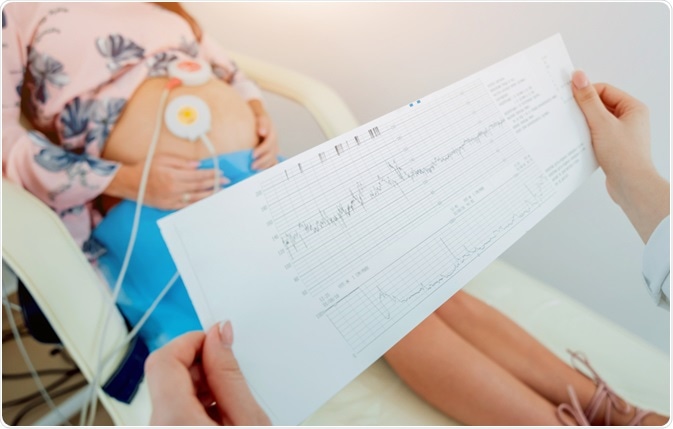Heart defects occur in about one percent of babies and are called congenital heart defects (CHDs). Approximately half are mild, with no major disruption to normal heart function. With the remainder, the defect is severe enough to require treatment.
About a quarter of these babies have critical CHDs. Without treatment, CHDs will cause the baby to become seriously ill and increase the chances of mortality.
 Image Credit: Roman Zaiets/Shutterstock.com
Image Credit: Roman Zaiets/Shutterstock.com
Anatomy of the heart
The heart is a double circulatory system, with four chambers designed to provide the whole body with oxygen at varying levels of pressure and demand. The right side is the collection and oxygenation department, pumping deoxygenated blood to the lungs, while the left side receives oxygenated blood and sends it to the whole body.
The heart is completely formed by eight weeks from conception, and this is the vulnerable period for CHDs to form.
What causes CHDs?
About 80% of CHDs occur for unknown causes. Among the rest, about one in five are due to genetic factors; some are associated with congenital syndromes such as Down syndrome, and others are due to maternal illnesses or infections. Maternal medications, including anti-seizure and acne medications, are known to increase the risk of CHD.
What are the commonest CHDs?
The five most common heart defects in fetuses are:
- Ventricular septal defect
- Transposition of the great vessels
- Coarctation of the aorta -the aorta is pinched, reducing the blood that can reach the body below the block
- Tetralogy of Fallot – a complex malformation of the heart with multiple defects
- Hypoplastic left heart syndrome – the left side of the heart is poorly developed, including both chambers, the aorta, and the aortic valve, so that the left ventricle may be too weak to pump enough oxygenated blood to the body
Ventricular Septal Defect
The ventricles are the two lower chambers of the heart, with muscular walls for pumping blood to either the lungs (right ventricle) or the body (left ventricle). They must be separated from each other to prevent the mixing of oxygenated with deoxygenated blood, thus maintaining adequate oxygen saturation to supply the body's cells, tissues, and organs.
A defect in the separating wall, called the septum, is called a ventricular septal defect (VSD). Small defects mostly heal spontaneously. Larger VSDs produce symptoms soon after or at birth and may require surgical closure with a patch.
VSD symptoms occur because of the higher pressures in the left ventricle, which causes blood to flow back into the right ventricle and the aorta with each heartbeat, causing blood to build up and congestion of the lungs.
Transposition of the Great Vessels
In this condition, the aorta and the pulmonary artery switch places. This converts the heart into two self-contained circuits pumping oxygenated and deoxygenated blood, respectively.
The left ventricle now pumps its oxygenated blood back to the lungs for further oxygenation rather than the body craving oxygen. The right ventricle pumps deoxygenated blood to the body while receiving deoxygenated blood from the body through the right atrium. This defect will kill the fetus soon after birth and requires urgent treatment.
Congenital Heart Defects (CHDs)
How do CHDs affect Children?
Children born with CHDs are at risk for respiratory infections. They may suffer from bacterial infection of the heart lining, called bacterial endocarditis, which can cause damage to the heart valves. To prevent this, all surgical procedures, including minor dental procedures, are often under antibiotic cover.
Signs and symptoms
The type and severity of the CHD determine the clinical features. Signs of deoxygenated blood entering the systemic circulation include a bluish tint of the nails and lips, called cyanosis, while lung congestion is signaled by fast breathing or respiratory distress. Poor overall heart function may manifest as tiredness during feeding and excessive sleepiness.
Diagnosis and treatment
Prenatal testing is carried out to screen for CHDs. In the first trimester, a maternal blood screen and ultrasound are carried out to look for chromosomal anomalies associated with CHDs.
A second-trimester screening is carried out by a detailed anomaly ultrasound scan for fetal abnormalities, including cardiac abnormalities, at 18-24 weeks of pregnancy. If any concerning findings are present, fetal echocardiography is useful for follow-up. A second maternal serum test, called a triple or quad screen, also picks up a higher risk of congenital disabilities.
Very few cases are asymptomatic and show no clinical features at all until later in life. Physical examination may pick up abnormal heart sounds called murmurs, complemented by tests such as an electrocardiogram, echocardiogram, chest X-ray, and cardiac catheterization.
Treatment depends on the specific CHD present. Some children require only simple surgeries to close the defect, while others need complex multi-stage procedures for their repair.
Cardiac catheterization is a less invasive procedure than open-heart surgery. Here a long flexible tube (catheter) is passed into the heart chambers. It can be used to inject dye or introduce a camera or instruments to treat the defect.
In some cases, CHD is not cured by surgery, but the procedure aims to allow the heart to pump well enough for the individual to lead a normal life.
The long-term outcome of CHDs
Since surgical procedures do not cure all people with a CHD, they may develop other illnesses over time. Some individuals may have arrhythmias or an irregular heart rhythm. Infective endocarditis is a constant risk. With the continued strain on one or more heart chambers, cardiomyopathy, or weakness of the heart muscle, may develop.
Pulmonary hypertension, with secondary disease of the heart, is another possible complication. For all these reasons, people with CHD should plan regular visits for their long-term care.
References
Further Reading